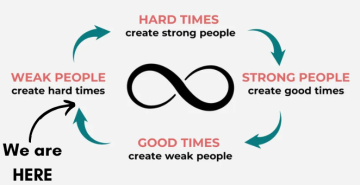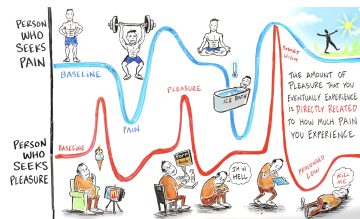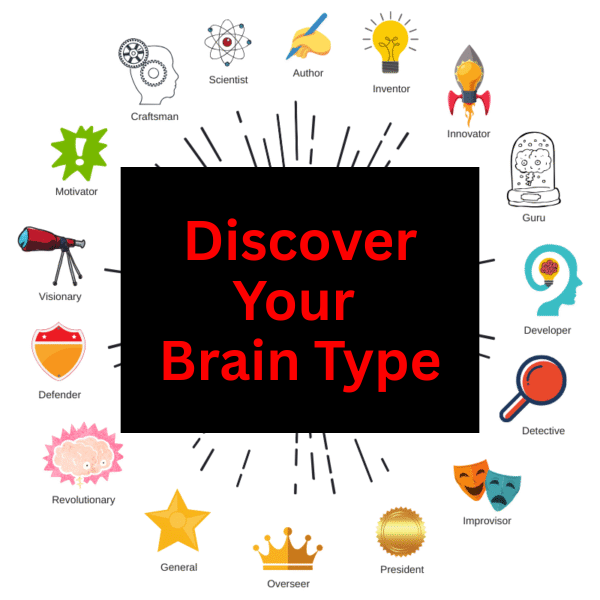Recent neuroscience research has revealed that dopamine isn’t primarily about reward – it’s about motivation and craving. A key experiment demonstrated this using two rats: one normal and one with depleted dopamine. Both rats could enjoy food and pleasures, but when effort was required (even just moving one rat-length to get food), only the rat with dopamine would make the effort.
This finding shows that dopamine drives us to pursue rewards rather than creating the pleasure itself. Humans with low dopamine can still experience pleasure (like eating or watching TV), but struggle to find motivation to exercise, pursue goals, or create things.
Our dopamine baseline constantly adjusts in response to our experiences. When we repeatedly experience easy pleasures (such as scrolling through social media or ordering food delivery), our baseline rises, making everyday activities feel less rewarding. This can create a destructive cycle – like constantly watching TED talks until they become boring, or needing increasingly intense experiences to feel satisfied.
The solution involves understanding the balance between pain and pleasure. The more friction or difficulty you experience, the greater the subsequent dopamine reward. For example, after a hard X Gym workout, dopamine levels can double over baseline for 2.5 hours. The pain itself doesn’t release dopamine – it’s the contrast after the pain ends that creates the surge.
The reason so few people nowadays can produce regular dopamine surges that lift their baseline is because of their low tolerance for pain. Life is too easy with our modern conveniences. The familiar saying is true:

We find rewards too easily now. We live in a world of instant gratification, filled with buttons, thermostats, food abundance, screens, and countless other conveniences that help us avoid physical effort and pain to achieve our rewards. This lowers our dopamine baseline, leading to an increased tendency to engage in behaviors that chase dopamine, leaving us feeling tired and unmotivated.

To reset to a higher dopamine baseline, first, take a break from the easy pleasure-seeking behaviors. “Fasting” from social media for 2-4 weeks, for instance, creates a period of relative “pain” or discomfort, but afterward, simpler pleasures become rewarding again.
Success in modern life increasingly depends on managing this balance – being able to delay gratification, embrace necessary difficulties, and understand that the pursuit itself, rather than just the reward, is what drives lasting satisfaction.
Next, put more effort into things before the reward. Exercise is the perfect example of this, but even things like cooking your dinner instead of going out or ordering in bring more reward and pleasure when eating it. In fact, the more effort you put in, the more dopamine you get back, and thus a higher baseline. This is why people who inherit money often become so depressed and unmotivated, while those who are self-made remain motivated, happier, creative, and inspired.
All this being said, there are two main ways people are motivated:
- “Away From” motivation is when someone is trying to move away from something like, “Becoming like my mom, who is obese with diabetes,” or some form of pain such as arthritis, or avoid knee replacement surgery, etc. This type of motivation can be effective in getting someone started, but as they move further away from that initial goal, motivation tends to drop off.
- “Toward” motivation. This is when people are inspired to move toward a goal, such as completing a marathon or looking good for a reunion or wedding, for instance. Toward motivation can last longer than away from motivation, but it also often wanes over time.
Anyone can attend a motivational speaker or seminar and get fired up for a day or two, but that motivation is chemically powered by dopamine, serotonin, and norepinephrine. It’s a chemical surge when you decide to change, either away from something or toward something. Unfortunately, they only surge because these chemicals aren’t sustainable for more than about 1-4 days. Then they crash. At that point, you might feel like you lost motivation, but it’s just that you ran out of those chemicals.
If you act when those chemicals are elevated, you will wire your brain for continued action, making habits easier to form. If you don’t take action during this Chemical surge, your brain will remember this as only a fantasy and will be more resistant to releasing that same chemical surge next time you try it. You can literally teach your brain not to believe yourself or take action with the motivation, chemical cocktail surge.
If you do take action within the time period of this chemical surge, that is what neuroscientists call “environmental architecture.” You can do this by taking action before motivation crashes. Here are some examples:
- Post your goals somewhere you will see them often (bathroom mirror, refrigerator, etc.). When you are thinking of doing a workout or a healthy meal versus sitting on the couch or consuming an unhealthy option, think about your goals and the outcome of your decisions, rather than the effort required. Most people do this backwards, and that’s why they end up making the wrong choice.
- Quality sleep: Get to bed before 11 pm (the earlier the better) and focus on quality sleep because that is when you are actually downloading dopamine into the “tank” for use tomorrow.
- Good, nutritious foods provide the necessary nutrients (especially tyrosine) to keep that “tank” full throughout the day.
- Sunlight, especially within the first two hours of waking (5 minutes sunny, or 15 minutes cloudy) primes your dopamine pump tp work better the rest of the day.
- Exercise, due to its inherent effort, provides an excellent motivational boost that lasts for hours afterward. If you do light exercise, you will need 2-3 hours. If you can handle intense X Gym exercise, though, you will only need 21 minutes, as the effort is condensed and the pain is higher, both working to spike your dopamine and fill that tank. Even a single Xercise snack, which takes only 3 minutes, can put significant amounts of dopamine into your tank. This is why so many people like the X Gym App: you can pick just one 3-minute Xercise. If you have limited time and motivation, it could be your secret weapon!
- Delete dopamine-producing apps. Move your furniture around. Throw out triggering foods. Do anything else that changes your environment to make old habits harder and signal your brain that your identity is shifting.
When your motivation chemicals crash on day 3-4, the actions you have taken during the surge will carry you through. Then, as you cotinue these new actions in your new environment, your habits will begin to change.
The next step is to view dopamine as a motivator for pursuit, rather than just seeking immediate rewards. This capacity for motivated pursuit, and more specifically, enjoying the process, when properly managed through an understanding of our dopamine system, is essentially unlimited, which makes exercise (and other activities) easier to do, to the point of even craving them. This is where we delve deeper into the realm of discipline versus motivation. For more on that subject, click here to see that post.
Lastly, when motivation isn’t enough, and especially if it wanes, it may be time to determine your brain type so you can discover your superpower brain training techniques and find your inner fire to achieve your goals!









